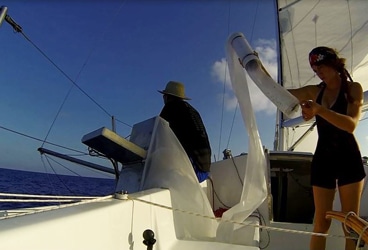
Today we pass from the western hemisphere into the eastern hemisphere, 24 hours vanish and like magic and an entire day disappears. All of our samples have to be properly logged with descriptions about things like, wind speed, sea state, time of day. All of our samples are logged using UTC time AKA Greenwich Mean Time. It’s crazy to think that when we log our sample today we are using a time zone that’s literally on the opposite side of the planet. Since longitude defines where time zones begin and end, Greenwich England is the beginning and end of time. King of all time zones.
During this voyage we are sailing 25% of the circumference of our planet. I’m not sure where all the time zones begin and end. Because of our research one clock on our boat is always is set to Greenwich mean time, which means I can’t tell you exactly what time it is we’re I’m at, but I can always tell you what time it is in England.
Time is very important in the modern world, but time as we know it only exists because we want it to. You think a dinosaur was ever worried about being late, or a whale swimming in the ocean cares what time it is? One of the most beautiful aspects of sailing the open ocean is that you can unplug from the modern world. There is no internet, no cellphones, no traffic, just the immense desolation of the open ocean.
All of that will be changing soon. Iridium claims they will be launching new satellites in 2017. They say by 2018 there will be 3G internet from the North Pole to the South Pole. It will make it possible to show you guys live video feed from the open ocean, which will be pretty cool for those following future expeditions. But that also means we won’t be able to get away from it all like we can now. The ups and downs of technology. No two ocean crossings are the same, even along the same route at the same time of year. I read an article that went viral about some guy who crossed the Pacific Ocean saying how he had seen less life than his last crossing ten years before so the Pacific Ocean must be in a state of serious decline.
Many people have seen this article with a picture of a guy standing in the companionway of a fancy looking very yellow sailboat. It amazes me what goes viral. I have done 13 trips back and forth to and from the Caribbean (same route as the Caribbean 1500) doing sailboat deliveries. Some trips I see a tremendous amount of marine life and some trips I see none. A simple observation lacks scientific rigor, yet these are the types of articles that spread like wildfire across the internet.
There are many other examples. Articles about islands of trash, giant robots that can clean our ocean of trash in 5 years, or the west coast is being fried byFukashima radiation?. None of these are true, yes Fukashima dumped a lot of radioactive isotopes into the water but according to a top radiation scientist I talked to at Woods Hole University, not nearly enough to fry the west coast of America. What do all these articles have in common? Doom and Gloom. As I said in an earlier blog, the media likes to sensationalize stories. Why, because it sells. There are HUGE problems facing our oceans, plastic trash is just one of many. The world’s oceans are in a state of decline, but the best way to teach people about these issues is not by saying “the sky is falling, the sky is falling”.
When I sailed the Pacific Ocean north to south in 2011 I didn’t see much life over those 10,000 miles, but we have seen quite a bit on this crossing. Fishing hasn’t been bad either. After the Hawaiian Islands the trades died off and moved south, we went south chasing after them but we couldn’t go fast enough to stay in the stronger winds. We weren’t completely becalmed but 5-7 knots of wind is pretty close. The first day sailing along at 1.5-2.5 knots is a nice break. Sailing this 30 foot day sailor 7,000 miles across the Pacific Ocean double handed is a lot of work. Light winds meant we could clean the inside of the boat, do maintenance, and wash the sweat out of our dirty clothes with a bucket of sea water. By the third day of moving 2 knots you start getting aggravated and when the wind picks back up is a huge relief.
We now have good easterly trade winds once again and are making good time. Nikki and I are holding up well, except my heat rash, and so is Sakura.
This type of research is very heavy on the processing side of things. After this expedition we will have to spend months in a lab in Baltimore, sifting through the samples, running various test and comparing results. Nikki will write a scientific paper (white paper) before the end of the year stating our findings from this expedition. Come July, she will interview potential high school interns to join her in the data analysis so that they can get a hands on experiences with ocean sample research in a lab setting. All of this is very expensive and we have only raised $700 of the $10,000 needed for our lab work. Any sized donation helps. Thank you. We sail for Science, Education and Exploration.








